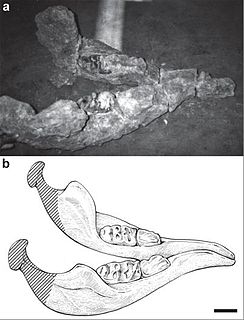 W
WA mastodon is any proboscidean belonging to the extinct genus Mammut that inhabited North and Central America during the late Miocene or late Pliocene up to their extinction at the end of the Pleistocene 10,000 to 11,000 years ago. Mastodons lived in herds and were predominantly forest-dwelling animals. They survived on a mixed diet and obtained food by browsing and grazing, somewhat similar to modern elephants, but probably with greater emphasis on browsing
 W
WA mastodon is any proboscidean belonging to the extinct genus Mammut that inhabited North and Central America during the late Miocene or late Pliocene up to their extinction at the end of the Pleistocene 10,000 to 11,000 years ago. Mastodons lived in herds and were predominantly forest-dwelling animals. They survived on a mixed diet and obtained food by browsing and grazing, somewhat similar to modern elephants, but probably with greater emphasis on browsing
 W
WThe Boaz mastodon is the skeleton of a mastodon found near Boaz, Wisconsin, USA, in 1897. A fluted quartzite spear point found near the Boaz mastodon suggests that humans hunted mastodons in southwestern Wisconsin. It is currently on display at the University of Wisconsin Geology Museum.
 W
WThe Burning Tree Mastodon site in Heath, southern Licking County, Ohio, represents the location where the most complete skeleton of American mastodon was found. It is dated to about 11,500 BP. It is believed that there was human presence at the site at that time.
 W
WThe Hiscock Site is an archaeological and paleobiological site in Byron, New York, United States that has yielded many mastodon and paleo-Indian artifacts, as well as the remains of flora and fauna not previously known to have inhabited Western New York during the late Pleistocene. Now owned by the Buffalo Museum of Science, it has been studied by archeological excavation and analysis since 1983.
 W
WThe Island 35 Mastodon was discovered on Island No. 35 of the Mississippi River in Tipton County, Tennessee, United States.
 W
WA mastodon is any proboscidean belonging to the extinct genus Mammut that inhabited North and Central America during the late Miocene or late Pliocene up to their extinction at the end of the Pleistocene 10,000 to 11,000 years ago. Mastodons lived in herds and were predominantly forest-dwelling animals. They survived on a mixed diet and obtained food by browsing and grazing, somewhat similar to modern elephants, but probably with greater emphasis on browsing
 W
WMammutidae is an extinct family of proboscideans that appeared during the Oligocene epoch and survived until the start of the Holocene. The family was first described in 1922, classifying fossil specimens of the type genus Mammut (mastodons), and has since been placed in various arrangements of the order. The name "mastodon" derives from Greek, μαστός "nipple" and ὀδούς "tooth", as with the genus, referring to a characteristic that distinguishes them from allied families. The genus Zygolophodon has also been assigned to this family. Mammutids ranged very widely, with fossils found in North America, Africa, and throughout Eurasia.
 W
WThe Manis Mastodon site is a 2-acre (1 ha) archaeological site on the Olympic Peninsula near Sequim, Washington, United States. During the dig, the remains of an American mastodon were recovered which had a 13,800 year old projectile made of the bone from a different mastodon embedded in its rib. The site was placed on the National Register of Historic Places in 1978.
 W
WThis list of museums and colleges includes locations exhibiting mastodon fossils.
 W
WThe Prairie Creek Site is an archaeological site in the southwestern part of the U.S. state of Indiana. Located approximately 3 miles (4.8 km) north of Washington in Daviess County, it lies along the southern bank of the westward-flowing Prairie Creek, a White River tributary. About 1 mile (1.6 km) to the east of the site, the stream leaves the Thousand Acre Woods, a heavily wooded area around a glacial lake; six miles downstream is the creek's confluence with the White River.
 W
WSinomammut is a proboscidean found in the Miocene of China. It was known from a single, fragmentary, mandible found in the 1990s. However, most of the specimen has been lost, leaving only the right ramus and an in-situ photograph of the mandible. The mandible was originally thought a gompothere closely related to Sinomastodon, but an analysis revealed it to actually be a mammutid that was a sister group to the well-known mastodon. It can be distinguished from the mastodon by its lack of lower tusks.
 W
WZygolophodon is an extinct genus of African, Asian, and European mammutid that lived from the Miocene to the Late Pliocene.